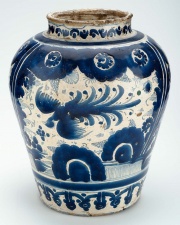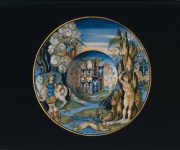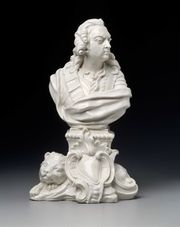Difference between revisions of "Tin glaze"
Jump to navigation
Jump to search
m (Text replace - "== Authority ==" to "== Sources Checked for Data in Record ==") |
|||
| (2 intermediate revisions by 2 users not shown) | |||
| Line 1: | Line 1: | ||
| − | [[File:00.389-SC43410.jpg|thumb|]] | + | [[File:00.389-SC43410.jpg|thumb|Tin-glazed earthenware<br>MFA# 00.389]] |
== Description == | == Description == | ||
| − | An opaque, white [ | + | An opaque, white [[ceramic%20glaze|ceramic glaze]] that contains [[stannic%20oxide|stannic oxide]]. Tin glazing was discovered by the Assyrians in the 9th century. As it spread from Moorish Spain (Hispano-Moresque ware) through Europe, several popular types of tin glazing were developed including [[majolica|majolica]] in Italy, [[faience|faience]] in France, and [[delftware|delftware]] in Holland. |
| − | [[File:41.105-E4334CR-d1.jpg|thumb|]] | + | [[File:41.105-E4334CR-d1.jpg|thumb|Maiolica plate<br>MFA# 41.105]] |
== Synonyms and Related Terms == | == Synonyms and Related Terms == | ||
| − | + | [[File:65.2014-SC39190.jpg|thumb|Bust of Louis XV<br>MFA# 65.2014]] | |
stanniferous glaze; glaçure stannique (Fr.); vidrado de estanho (Port.); tin-glazed earthenware; tin-enameled earthenware | stanniferous glaze; glaçure stannique (Fr.); vidrado de estanho (Port.); tin-glazed earthenware; tin-enameled earthenware | ||
| − | == | + | == Resources and Citations == |
| − | |||
| − | |||
| − | |||
| − | |||
| − | |||
| − | |||
| − | |||
* Ralph Mayer, ''A Dictionary of Art Terms and Techniques'', Harper and Row Publishers, New York, 1969 (also 1945 printing) | * Ralph Mayer, ''A Dictionary of Art Terms and Techniques'', Harper and Row Publishers, New York, 1969 (also 1945 printing) | ||
| Line 22: | Line 15: | ||
* Robert Fournier, ''Illustrated Dictionary of Practical Pottery'', Chilton Book Company, Radnor, PA, 1992 | * Robert Fournier, ''Illustrated Dictionary of Practical Pottery'', Chilton Book Company, Radnor, PA, 1992 | ||
| − | * ''Encyclopedia Britannica'', http://www.britannica.com Comment: "tin-glazed earthenware." | + | * ''Encyclopedia Britannica'', http://www.britannica.com Comment: "tin-glazed earthenware."(Accesseed 4 Feb. 2005) |
* Art and Architecture Thesaurus Online, http://www.getty.edu/research/tools/vocabulary/aat/, J. Paul Getty Trust, Los Angeles, 2000 | * Art and Architecture Thesaurus Online, http://www.getty.edu/research/tools/vocabulary/aat/, J. Paul Getty Trust, Los Angeles, 2000 | ||
Latest revision as of 11:43, 4 August 2020
Description
An opaque, white Ceramic glaze that contains Stannic oxide. Tin glazing was discovered by the Assyrians in the 9th century. As it spread from Moorish Spain (Hispano-Moresque ware) through Europe, several popular types of tin glazing were developed including Majolica in Italy, Faience in France, and Delftware in Holland.
Synonyms and Related Terms
stanniferous glaze; glaçure stannique (Fr.); vidrado de estanho (Port.); tin-glazed earthenware; tin-enameled earthenware
Resources and Citations
- Ralph Mayer, A Dictionary of Art Terms and Techniques, Harper and Row Publishers, New York, 1969 (also 1945 printing)
- Robert Fournier, Illustrated Dictionary of Practical Pottery, Chilton Book Company, Radnor, PA, 1992
- Encyclopedia Britannica, http://www.britannica.com Comment: "tin-glazed earthenware."(Accesseed 4 Feb. 2005)
- Art and Architecture Thesaurus Online, http://www.getty.edu/research/tools/vocabulary/aat/, J. Paul Getty Trust, Los Angeles, 2000


